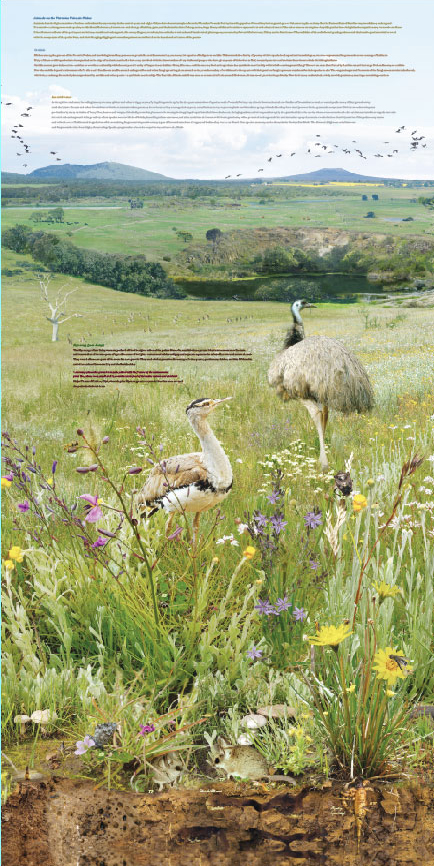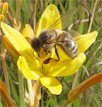
All images copyright© inherit earth
panel 7
Wurdi Youang
Aboriginal cultural practices went beyond the collection of food and the managing of their ‘gardens’. Aborigines on the western plains built stone structures out of the basalt rocks [repetition] left from the lava flows of the volcanoes. These stone structures included walls and channels for aquaculture, stone houses with bark roofs [currentlyspelt rooves – change to roofs] around Lake Condah and what seem like gathering places for meetings or religious practices around Lake Bolac and on the Werribee Plains near the You Yangs. Some of these stone walls built by Aboriginal groups have been mistaken for the dry stone walls built later by Europeans all over the plains. They are similar in concept and structure, though maybe not in purpose. The Aboriginal-built stone walls around Lake Condah were part of a large elaborate eel farming system. Near the You Yangs is an ancient circle of stones roughly egg-shaped and about fifty (50) metres in diameter, with three larger rocks at the western end. This structure, now called Wurdi Youang, has been described as a small Stonehenge. Nothing is known about its purpose although it appears to have a religious or spiritual sense about it. There is also speculation that it had an astronomical purpose and archaeologists have measured the direction of the large rocks against the range of the setting sun. Wurdi Youang is now owned and managed by the Wathaurung Aboriginal Cooperative Limited.
How does your garden grow?
The fine clay soils of the lava plains have been created by the weathering of rocks, the breaking down of rocks by lichens, mixed with sediments washed in by floods and dust blown in by winds, through constantly changing climate conditions. These acidic black and red clay soils were further developed by a complex interaction of behaviour by animals and plants, many too small to see, constantly enriching the soil, with dung from animals recycling elements like nitrogen, carbon and phosphorous, essential for growth. Regular burns added carbon, keeping soils loose and able to hold water. A significant feature of grasslands is that much of the life is hidden underground. Approximately 60% of what is termed plant ‘biomass’ is below the surface, varying from place to place and season to season. Most of the plant species have large tubers or long roots to store nutrients to survive the summer dry and re-sprout quickly after burning or the breaking of droughts. There are also a huge variety of fungi, bacteria, protozoa, nematodes, microarthropods, worms, ants, and dung beetles carrying out all kinds of activities that keep mixing and moving things around underground. Indigenous plants cannot reproduce without a variety of pollination activities by flies, wasps, birds and beetles. Dung beetles and ants take dung, seeds, grass and other vegetable matter down into the soil to keep it enriched with nutrients. The holes they dig allow water and air to penetrate the soil and constantly cycle nutrients into the earth, where the roots of plants can reach them.
Animals on the Victorian Volcanic Plains
Australia has the highest number of animal extinctions for any country in the last 200 years and eight of those have been marsupials from the Victorian Volcanic Plains, including species of wallabies, bettongs and quolls. Others not quite extinct, like the Eastern Barred Bandicoots, are critically endangered. You can still see kangaroos on the plains, not far from Melbourne, but removal and change of habitat, guns, and the introduction of sheep, cattle, dogs, foxes, rabbits and cats have squeezed out or decimated most of the other smaller marsupials. Anything under knee-height has been particularly vulnerable to foxes. Other former residents of the plains, not technically considered endangered, like emus, dingoes, wombats, koalas in the woodlands and brush-tailed phascogales, are certainly few and far between, if they can be found at all. The activities of the soft-footed grazing animals and their native predators had evolved with the ecosystems of the plains flora, and their foraging, digging and excretion patterns contributed to the health and existence of the plants.
